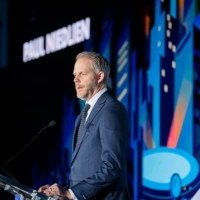Rebuttal – ‘Denverization’ is not the problem on Troost

A rendering shows UC-B’s proposed development at Linwood Boulevard and Troost Avenue. COURTESY OF DRAW ARCHITECTURE + URBAN DESIGN LLC
By GIB KERR, special to The Kansas City Star, Dec. 12, 2018
I grew up here in Kansas City, just a few blocks from Troost Avenue. For my entire life, Troost has been an ugly dividing line — both physically and psychologically — between black and white. Politicians, ministers and civic leaders have forever implored employers and developers to invest along the Troost corridor.
For decades, middle-class residents have been abandoning Troost and the urban core for the greener pastures of the suburbs. The population along Troost plummeted. Businesses, churches and schools closed in staggering numbers. The area became a desolate urban wasteland.
Over the last couple years, however, several pioneering developers have made the bold decision to risk their capital and build new apartments along the Troost corridor. We are witnessing some of the first new construction on Troost in our lifetime.
Most exciting of all (to me, at least) is that a new generation is not only willing to move there, but they’re excited to be part of a 21st-century urban environment where black and white Kansas Citians (along with Hispanics, Asians and maybe even millennials who grew up in Johnson County) can all live together without regard to the racial hang-ups that seemed so big to previous generations.
Maybe Kansas City can show America how to heal the wounds that have divided us for too long. These new developments are not just building a bridge across Troost. They are weaving a new urban quilt that earlier generations could never have imagined.
Granted, we have a long, long way to go. But this seems to be a very promising beginning.
So why does The Kansas City Star’s editorial board see only the manure and not the pony in the barn? Its recent editorial rebuking the “Denverization of Kansas City” completely misses the mark.
Yes, we need more affordable housing. But first we need to restore the urban population that we have lost over the last 50 years.
“Gentrification” is the dirty new buzzword among those for whom the perfect is the enemy of the good. In order for our urban core to thrive, we need to increase population density. We need to replace the thousands of residents who moved away, even if some of those new residents are (God forbid) “hipsters” who come from more affluent backgrounds.
I’m pretty sure that the residents moving into new apartment projects along the Troost corridor are not displacing anyone. They are moving into new housing units mostly built on vacant lots.
The economically distressed areas of the city’s East Side are full of thousands of abandoned houses, which are now attracting investors to renovate them — and in the process delivering more affordable housing options.
Jason Segedy, director of planning and urban development for the city of Akron, Ohio, notes that the problem with economically distressed areas is not inequality. The problem is poverty. Too many residents are equally poor.
By introducing a more diverse socioeconomic population, a rising tide will lift all boats. Higher population leads to healthier businesses, schools, churches and a stronger community overall. Remember, we closed more than 20 schools in the Kansas City Public Schools district over the past decade. Imagine what a few thousand new residents could do for our schools.
My observation is that both the developers and their residents along this new urban frontier are keenly sensitive to the cultural legacy of Kansas City’s East Side, which must not only be respected but celebrated. Rather than disparaging the economic progress along Troost, we should encourage its continuation and make Kansas City a model for American urban renewal.
Gib Kerr is a commercial real estate broker focusing on investment sales, with an emphasis on development transactions in Downtown Kansas City. He served as co-chair of the sell-out Downtown Office Summit meeting for the Downtown Council in October at Crown Center.



